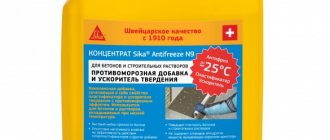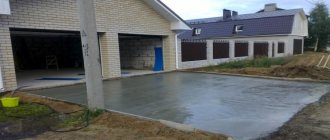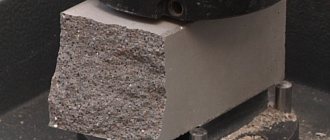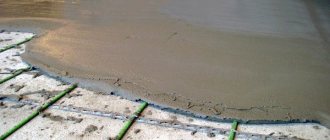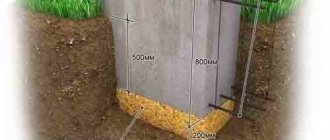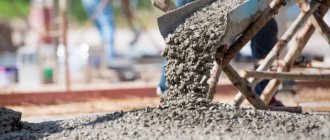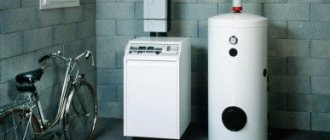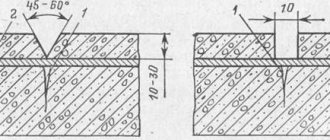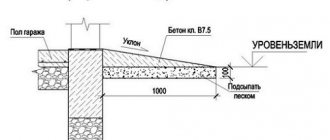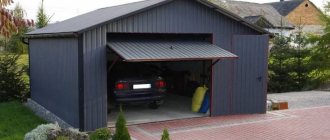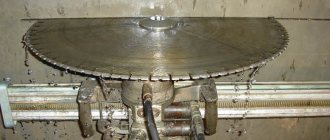Underwater concreting is a special technology for laying concrete mortar, used when it is not possible to pump out water or remove it by other means.
Most often, the method is in demand for the construction of large reinforced concrete structures, the operation of which involves significant loads. Bridges, dams, other hydraulic structures, as well as power line supports, wells in rock are structures during the construction of which in many cases they resort to underwater concreting. Concreting in water is also used in projects of lesser scale. The inability to establish drainage from a pit when the groundwater level is high is a common situation during construction work.
There are several methods for pouring concrete into water:
- “vertically moving pipe” (VPT) technology;
- VR or concreting, due to the ascension of the solution;
- compacting the concrete mixture;
- laying concrete in bunkers;
- bagging method.
The main thing to remember when carrying out concrete-laying work is that the main calculated mass of the solution should not come into contact with water in order to avoid washing out the cement; the concreting process must proceed continuously until the level planned by the project is reached.
Preparatory work
Before you begin laying concrete directly into the water, you need to draw up a project that describes the order and progress of the work, the volume of material, the necessary equipment and accessories. As a rule, at significant depths, divers are required to outline a plan for clearing the concrete area or clear it manually, install the formwork, and regulate the placement of pipes and hoses through which the pouring mixture flows.
The concrete solution is prepared at the factory in accordance with a certain recipe. For different methods involving pouring into water, the grade of concrete should be 10-20% higher than if laying was carried out under normal conditions; in this case, it is necessary to reduce the ratio of water and cement in the finished solution. Water slows down the hardening process, so it is advisable to introduce accelerators and plasticizers. Anti-erosion additives increase the resistance of structures to erosion.
Special requirements are also imposed on formwork. She must be:
- impermeable to the concrete mixture, including at joints;
- holds its shape well despite the water pressure;
- easy to install.
From the outside, the formwork is additionally reinforced with stone or sandbags.
Basic properties
Among the most important technological properties of the concrete mixture are:
- density;
- strength;
- waterproof;
- plastic;
- fire resistance.
Of these, the main indicator is strength, which is expressed in the ability to resist destruction from loads. An increase in the latter is allowed only up to a certain limit. The strength of a material is determined by its brand. It refers to the compressive strength of cubes whose side is 20 cm. They harden after pouring for a month. The tensile strength is expressed in kg/cm2.
After familiarizing yourself with the concept of a brand, you can find out that the following values are established in the documentation. For ordinary concrete, the figure varies from 25 to 600. As for lightweight concrete, the normal range is from 10 to 300. Strength depends on how active the cement is. This parameter is influenced by the quality of crushed stone, sand, water and gravel, as well as the conditions of transportation, mixing, age, laying and hardening of concrete.
When considering the properties of a concrete mixture, you should definitely pay attention to the density. The described material is not completely dense, because it contains air pores that are formed when water evaporates or air penetrates inside
Density is the degree to which a volume is filled with solid matter. So, if the density is 0.95, then 95% of the volume is solid materials, and 5% is pores.
In order to obtain dense concrete, the amount of water should be reduced and the aggregate grains should be selected in different sizes. This will help reduce the number of voids. Among the properties of a concrete mixture, plasticity should also be highlighted. It is determined by the mobility of the composition, which, when laid, must fill all bends, voids and cavities. Concrete can be:
- cast;
- plastic;
- tough.
The plasticity index of the mixture is assessed by a device called a cone. This tool is a steel mold without a bottom in the form of a cone.
Another important property is water permeability. Its degree is characterized by the highest water pressure at which liquid percolates through the sample. Water resistance depends on the amount of water pressure, density and structure, as well as hardening conditions, density and age of concrete.
When becoming familiar with the properties of a concrete mixture, you will need to pay attention to fire resistance. This is the ability of a material, which is expressed in resistance to destructive factors associated with high temperature
Concrete must withstand normal use up to 250˚C.
In addition, you need to pay attention to the shrinkage of the material. When hardening in air, concrete decreases in volume
This happens faster on the outside than on the inside, resulting in cracks. Shrinkage, as a rule, is 0.15 mm per 1 m. If you choose the composition of the solution, you can reduce the amount of shrinkage or prevent it altogether.
A special feature of pouring is the release of heat during hardening of the mixture. Therefore, an increase in temperature can be observed in constructed structures even at low ambient temperatures. This property allows concreting to be carried out in winter conditions without heating.
Vertical pipe method
To fill in this way you will need:
- concrete pumps or other equipment that provides continuous supply of solution;
- concrete pipes with a diameter of 200-300 mm, consisting of links up to 1 m long, equipped with quick-release locks;
- equipment of the platform above the concreting site: traverse, winch, lifting mechanism.
The pipe is installed vertically, in contact with the lower point of concreting, while a small gap is allowed between the bottom and the edge of the pipe. A floating wad, such as burlap or a wooden plug, is placed inside, which is subsequently pressed through with liquid concrete and displaces water and air. In more technologically advanced options, the ends of the pipe are equipped with valves that open after the entire pipe is filled with concrete. The solution is fed through a funnel until the layer of laid concrete reaches a height of 0.8-1.5 m from the bottom edge of the pipe.
After this, the pipe is raised by one link, the upper element is dismantled, and the lower end must remain in the concrete. Filling continues until the required volume. It is worth noting that using one pipe you can pour an element with a radius of 6 m, therefore, if the concreting area is larger, you should use a system of concrete pipes with a pitch of 10-11 m.
Basic requirements for ready-mix brands
So, what is hydraulic concrete: GOST with basic requirements? They are:
- Before taking on a solid form, the material must be able to mix, have a certain degree of movement and ease of installation;
- during the hardening phase, do not lose solidity, have no layers and do not crack;
- have precise curing times in accordance with defined deadlines and tasks;
- minimizing the cost of the finished mixture and the consumption of the cement mixture;
- exact correspondence of the composition of fillers and aggregates to the required task, the presence of sand fractions, gravel and crushed stone of a certain shape and the required amount of microadditives and chemical additions.
Cement concrete is also divided into light, heavy and especially heavy. It all depends on the total volumetric mass (in kg per cubic meter). The filling composition of especially heavy concrete is also subject to certain conditions and requirements for the purity of the mixture. Very often it is especially heavy concrete that is used in the regions of the Far North, so processes and the possibility of winter work are of paramount importance. For this purpose, special standards and additives have been developed.
In normal climate conditions, on the contrary, the possibility of rapid hardening is most important, which is achieved by using heat treatment and introducing special chemical additives that accelerate the hardening process of this material
How to pour concrete using the ascending solution method (BP)
The method involves preliminary filling of the concreted object with stone or crushed stone so that the voids make up 45% of the volume. Concrete solution is supplied through pipes of small diameter 37-100 mm, which, rising upward, naturally fills the voids in the backfill, completely displacing water. The area that can be filled using one pipe is determined by the radius of distribution of the mixture: R = 3 m when feeding the solution into a stone fill, 2 m into a crushed stone fill. Two filling methods are used: pressure and non-pressure.
Pressure or injection method VR
Pipes are installed directly into rock or crushed stone riprap. The cement mortar is supplied under pressure to the base of the fill, then rises, ensuring a monolithic setting with the aggregate. After completion of the work, the pipes remain in the concrete block, the excess is cut off.
Classification, technical characteristics
Experts classify hydraulic concrete according to its technical characteristics specified in GOST 26633-2012. The main ones are considered to be compressive strength, bending strength, as well as axial tension; water resistance and frost resistance tests are carried out.
The most common method for determining the strength of a hardened composition is the destruction of a cube with an edge of 15 cm. For hydraulic concrete, this indicator can vary in strength classes from B10 to B40, depending on the technical requirements. Axial tension is marked with the indices Bt 0.4 - Bt 4 and taken in increments of 0.2, they show the formation of a crack when the structure is stretched. Similar indicators for bending from Btb 0.4 - Btb 8, where the same step is applied, and the load is applied to bend the element until a crack appears.
The water resistance grade is measured at the age of 180 days after pouring the solution. During operation, hydraulic concrete cannot allow water to pass through. Therefore, the grade of its water resistance ranges from W2 - this means that the sample can withstand a pressure of 0.2 MPa during testing, to W8 in increments of 2. When producing waterproof concrete for special purposes, plasticizers are used, the proportion of cement increases, and the indicator is brought to W12.
Based on frost resistance, hydraulic concrete is divided into grades from F50 to F300 in increments of 50. The number after the index means the number of freeze-thaw cycles that the composition can withstand before losing a quarter of its strength. The addition of certain components allows you to obtain hydraulic concrete with an F400 index. The test is carried out in a freezer with varying temperatures for 28 days, and a frost resistance mark is assigned.
In accordance with GOST, hydraulic concrete must have a certain mobility so that it can be laid correctly. The composition must harden evenly, without delamination or cracking, and gain strength within the required period.
Laying concrete at shallow depths
The described methods have become widespread when forming concrete structures at a considerable depth, up to 50 m. Is it possible to pour concrete using simpler and less expensive methods if the depth does not exceed 2 m, and the work itself is aimed at repairing existing monolithic structures? Indeed, to restore the integrity of a damaged structure, level the bottom or fill a non-critical object, there is a method of laying concrete in bags.
Bags filled with fresh solution and sewn up are placed on the base or sealed into large cavities of damaged structures. Burlap allows water to pass through, but protects the concrete from spreading. When concreting a large space, the bags are sewn together and reinforced.
Another method of underwater concreting at a depth of up to 1.5-2 m is the island or tamping method. The method requires a high speed of supply of cement mortar and the use of a vibrator to compact the next portion of concrete, however, it allows concreting of non-horizontal surfaces (for example, banks). In addition, no reinforcement is required and there are no high requirements for the class of concrete.
When pouring concrete into water, you must remember that this is a technologically complex process that requires careful preparation, drawing up design documentation and compliance with building regulations. Accurate adherence to laying technology will allow you to avoid emergency situations both during underwater concreting and during subsequent operation of the facilities.
Testing and marking
To check the quality of hydraulic concrete, it is tested for:
- Strength. As a result of tests, during which the test object is stretched and compressed on measuring stands, cracks should not form in the material. The most popular classes are B10÷B40.
- Frost resistance. The product is placed in a freezer with constantly changing temperatures for 28 days; the number of freezing and thawing cycles is recorded and, as a result, the product is classified indicating the number of complete cycles it has undergone without significant loss of its properties: F50÷F300 (maximum F400).
On a note! The following brands are most often used in construction: F300, F200, F100, F50. To obtain a number of cycles greater than 400, it is necessary to add special additives to the product.
Waterproof. The concrete is immersed in water with different salt and mineral compositions, where it remains for 180 days, subjected to hydrostatic pressure. Then, by cutting a part of the concrete, the level of water resistance is determined and the material is assigned a class: W2÷W8 (using special additives it can be increased to W12). The number in the marking means that the material does not allow water to pass through at pressures of 0.2 MPa, 0.4 MPa, 0.6 MPa, and so on.
On a note! Assignment of a certain class or grade to a material occurs solely on the basis of testing.
conclusions
Each method is effective in its own way. Concrete used to construct structures in water must meet the following requirements:
- be liquid enough to spread easily in the pipe;
- there should be enough filler so that the mixture is not too viscous;
- To increase the plasticity of concrete, experts advise diluting the composition with a suspension of calcium hydroxide.
Carrying out concreting work in water is one of the most difficult construction activities, requiring highly qualified knowledge, practical skills, and special equipment. Nevertheless, this is an important stage in the construction of hydraulic structures.
Thanks to concreting technologies in water, it is possible to build dams, bridges, breakwaters, hydroelectric power stations and other structures that are highly durable.
